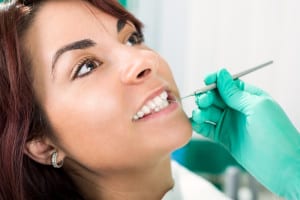 Your teeth begin to accumulate a sticky film of plaque immediately after you brush and floss them. The more time passes, the thicker the film becomes until you can see and feel the plaque on your teeth. If you don’t clean them again soon, then plaque can quickly calcify (harden) into tartar, and it will remain there until your hygienist removes it during your next dental cleaning. The bacteria that are found in plaque and tartar are the building blocks of issues like cavities and gingivitis, therefore keeping them under control with regular dental cleanings is vital to keeping your smile healthy.
Your teeth begin to accumulate a sticky film of plaque immediately after you brush and floss them. The more time passes, the thicker the film becomes until you can see and feel the plaque on your teeth. If you don’t clean them again soon, then plaque can quickly calcify (harden) into tartar, and it will remain there until your hygienist removes it during your next dental cleaning. The bacteria that are found in plaque and tartar are the building blocks of issues like cavities and gingivitis, therefore keeping them under control with regular dental cleanings is vital to keeping your smile healthy.
Two Main Ingredients of Plaque and Tartar
At any given moment, a healthy human mouth contains over 600 different kinds of bacteria. Two specific ones, however, are often recognized as particularly harmful for the substances they produce.
Streptococcus Mutans
Streptococcus mutans are a common contributor to dental plaque, and one of the leading causes behind tooth decay and cavities. The bacteria consume sugar and other carbohydrates, then metabolize them into acids that weaken the mineralized outer layer of your teeth, called enamel. The longer plaque and tartar stay on your teeth, the more acid that S. mutans can produce. Eventually, the acid can destroy enamel and leave your teeth vulnerable to bacteria-caused tooth decay.
Porphyromonas Gingivalis
Porphyromonas gingivalis are another common type of bacteria found in dental plaque and tartar that tend to gravitate toward your gum tissues. P. gingivalis produce molecules on their surfaces that fool your immune system and lead to rampant soft tissue inflammation. As they accumulate and infect your gum tissues, P. gingivalis cause redness, swelling, irritation, and bleeding, and before long, the infection (gingivitis) will lead to destructive gum disease.
Control Through Dental Cleanings
Because you can’t remove tartar with your toothbrush, attending a dental checkup and cleaning appointment at least once every six months is necessary to control harmful oral bacteria. During your visit, your hygienist will use professional equipment to remove plaque and tartar, and then polish your teeth to make it more difficult for bacteria to gather on them.







